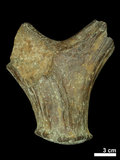哺乳動物牙齒的基本構造
推薦分享
後設資料
- 資料識別:
- 系統識別碼:0b00000180ab970c
- 資料類型:
- 型式:合集
- 紀錄類別:脊椎動物化石知識單元
- 主題與關鍵字:
- 學域-大分類:地質-化石類
- 分類:脊椎動物化石
- 拉丁界名:Animalia
- 中文界名:動物界
- 拉丁門名:Chordata
- 中文門名:脊索動物門
- 拉丁亞門名:Vertebrata
- 描述:
- 簡介:哺乳動物牙齒的基本結構由琺瑯質、齒質與白堊質所組成。牙齒的主要成分為齒質,齒質的內部形成膨大的牙髓腔與下方的齒根腔,內含豐富的神經與血管。琺瑯質為堅硬的構造,形成齒帽,即牙齒最外緣的部位,主要的功能就是在咀嚼和研磨食物。此外,從牙齒從口腔齒槽生成的位置,齒槽以上稱為齒冠,齒槽以下稱為齒根,齒根的外圍則由白堊質所包裹。哺乳動物的牙齒屬於異型齒,意指牙齒可以依其型態與功能,分為門齒、犬齒、前臼齒與臼齒,而有別於爬蟲類動物的同型齒。門齒與犬齒為單齒根牙齒,前臼齒與臼齒則為多齒根牙齒。此外,有別於其它脊椎動物的牙齒得以持續地更替換新,大多數的哺乳動物只有兩組牙齒,第一組稱為乳齒,在長出數月或數年後脫落,第二組牙齒為恆齒,長出後持續至終生。
- 哺乳動物牙齒的種類與數目,可以利用齒列的基本齒式來表達。哺乳動物完整的牙齒,應該是上下左右門齒各三顆、犬齒各一顆、前臼齒四顆與臼齒四顆,基本齒式為: 3. 1. 4. 3, 或上下齒式分開表列為:3. 1. 4. 3/3. 1. 4. 3, 所以總共有44顆牙齒。然而,隨著不同的種類與食性,各類哺乳動物的牙齒型態與數目均有很大的差異,例如:
- 豬:3.1.4.3/3.1.4.3 = 44
- 牛:0.0.3.3/3.1.3.3 = 32
- 馬:3.1.3.3/3.1.3.3 = 40
- 鼠:1.0.0.3/1.0.0.3 = 16
- 人:2.1.2.3/2.1.2.3 = 32
- 貓:3.1.2-3.1/3.1.2.1 = 28-30
- 犬:3.1.4.2-3/3.1.4.2-3 = 40-44
- 每一種不同型態的牙齒都有其獨特的功能,一般而言,門齒主要用來切割與收集食物,犬齒主要是用來獵捕並刺殺獵物,而前臼齒與臼齒則是用來研磨並切割食物。Mammals Basic Structure哺乳動物化石牙齒基本構造The mammalian tooth is made up of enamel, dentin and cementum. Dentin makes up most of the tooth, and inside is the pulp chamber and root canal filled with nerves and blood vessels. The enamel is a very hard structure that forms the outer crown. This is the outermost part of the teeth and is used for chewing and grinding food The crown of the tooth is the area above the outside of the tooth space, while the area inside the tooth space is known as the root. The outside of the root is covered with cementum. Mammals have heterodont dentition, meaning that the teeth can be divided into incisors, canines, premolars and molars depending on their shape and function. This is different to the homodont dentition found in reptiles. Incisors and canines have a single root while premolars and molars have multiple roots. Unlike other vertebrae animals that can continually replace their teeth, most mammals only have two sets of teeth. The first, known as the milk teeth, fall out after several months or years. The second set is the permanent teeth and last for the rest of their life.
- The types and numbers of teeth in mammals can be expressed using the dental formula. A typical set of mammalian teeth should consist of 3 upper and lower incisors on each side, 1 canine on each side, 4 premolars and 4 molars. The dental formula is therefore: 3.1.4.3. Or if the upper and lower teeth are different, written as: 3.1.4.3/3.1.4.3. This means there is a total of 44 teeth. The types and numbers of teeth in each mammal can vary greatly depending on the species and diet, however. For example:
- Pig: 3.1.4.3/3.1.4.3 = 44
- Cow: 0.0.3.3/3.1.3.3 = 32
- Horse: 3.1.3.3/3.1.3.3 = 40
- Mouse: 1.0.0.3/1.0.0.3 = 16
- Human: 2.1.2.3/2.1.2.3 = 32
- Cat: 3.1.2-3.1/3.1.2.1 = 28-30
- Dog: 3.1.4.2-3/3.1.4.2-3 = 40-44
- Each type of teeth has its own unique function. Generally speaking, incisors are used for cutting and collecting food, canines for hunting and killing prey, and premolars and molars for grinding and cutting up food.
- 出版者:
- 數位化執行單位:國立自然科學博物館:地質學組脊椎動物化石學
- 管理權:
- 典藏單位:國立自然科學博物館
- 使用聲明:館內公開瀏覽
授權聯絡窗口
- 鍾舜丞
04-23226940*762
chungnmns@nmns.edu.tw






